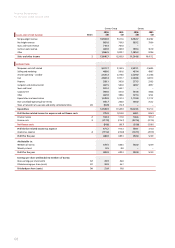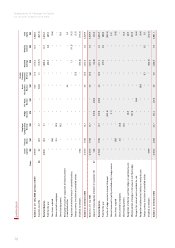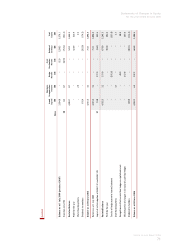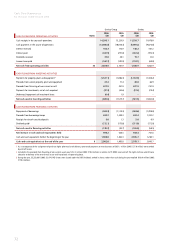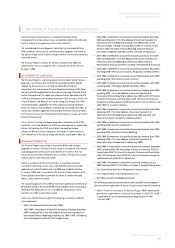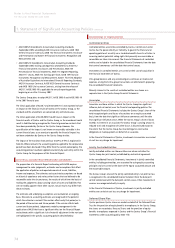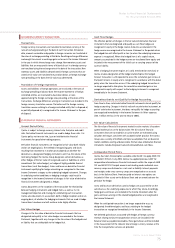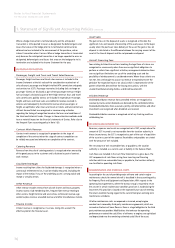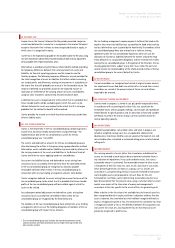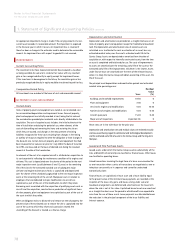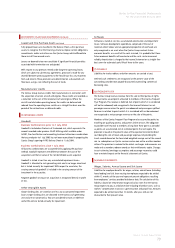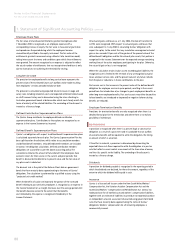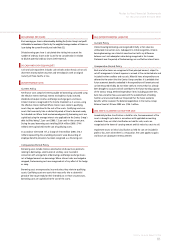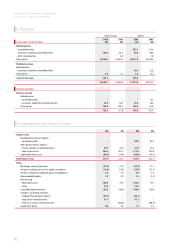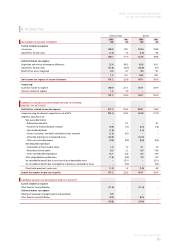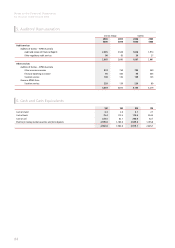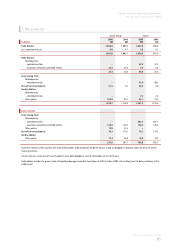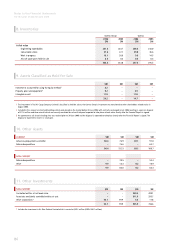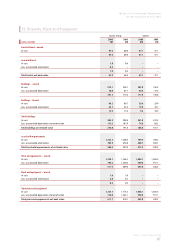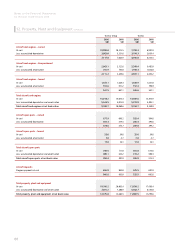Qantas 2006 Annual Report Download - page 80
Download and view the complete annual report
Please find page 80 of the 2006 Qantas annual report below. You can navigate through the pages in the report by either clicking on the pages listed below, or by using the keyword search tool below to find specific information within the annual report.
78
Notes to the Financial Statements
for the year ended 30 June 2006
An appropriate impairment charge is made if the carrying amount of a non-
current asset exceeds its recoverable amount. The impairment is expensed
in the financial year in which it occurs. An impairment loss is reversed if
there has been a change in the estimates used to determine the recoverable
amount. An impairment loss with respect to goodwill is not reversed.
(P) INVESTMENTS
Current Accounting Policy
The investment in Air New Zealand Limited (Air New Zealand) is classifi ed
as being available-for-sale and is stated at fair value, with any resultant
gain or loss recognised directly in equity, except for impairment losses.
If this investment is derecognised in the future, the cumulative gain or loss
previously recognised directly in equity would be transferred to profi t or loss.
Comparative Period Policy
All investments are recorded at the lower of cost and recoverable amount.
(Q) PROPERTY, PLANT AND EQUIPMENT
Owned Assets
Items of property, plant and equipment are stated at cost or deemed cost
less accumulated depreciation and impairment losses. Items of property,
plant and equipment are initially recorded at cost, being the fair value of
the consideration provided plus incidental costs directly attributable to the
acquisition. The cost of acquired assets includes: the initial estimate at the
time of installation and during the period of use, when relevant, of the
costs of dismantling and removing the items and restoring the site on
which they are located, and changes in the measurement of existing
liabilities recognised for these costs resulting from changes in the timing
or outflow of resources required to settle the obligation or from changes in
the discount rate. Certain items of property, plant and equipment that had
been revalued to fair value on or prior to 1 July 2004, the date of transition
to A-IFRS, are measured on the basis of deemed cost, being the revalued
amount at the date of that revaluation.
An element of the cost of an acquired aircraft is attributed on acquisition to
its service potential reflecting the maintenance condition of its engines and
airframe. This cost is depreciated over the shorter of the period to the next
major inspection event (usually between 8 and 12 years) or the remaining
life of the aircraft. The estimated standard cost of subsequent major
airframe and engine maintenance checks is capitalised and depreciated
over the shorter of the scheduled usage period to the next major inspection
event or the remaining life of the aircraft. Manpower costs in relation to
employees that are dedicated to major modifications to aircraft are
capitalised as part of the cost of the modification to which they relate.
Borrowing costs associated with the acquisition of qualifying assets such as
aircraft and the acquisition, construction or production of significant items
of other property, plant and equipment are capitalised as part of the cost of
the asset to which they relate.
When an obligation exists to dismantle and remove an item of property, the
present value of the estimated cost to restore the site is capitalised into the
cost of the asset to which they relate and a provision created. The
unwinding of the discount is treated as a finance charge.
Depreciation and Amortisation
Depreciation and amortisation are provided on a straight-line basis on all
items of property, plant and equipment except for freehold and leasehold
land. The depreciation and amortisation rates of owned assets are
calculated so as to allocate the costs or valuation of an asset, less any
estimated residual value, over the asset’s estimated useful life to the
Qantas Group. Assets are depreciated or amortised from the date of
acquisition or, with respect to internally constructed assets, from the time
an asset is completed and held ready for use. The costs of improvements
to assets are amortised over the remaining useful life of the asset or the
estimated useful life of the improvement, whichever is the shorter. Assets
under finance lease are amortised over the term of the relevant lease or,
where it is likely the Qantas Group will obtain ownership of the asset, the
life of the asset.
The principal asset depreciation and amortisation periods and estimated
residual value percentages are:
Years
Residual
Value
(%)
Buildings and leasehold improvements 10-50 0
Plant and equipment 3-40 0
Jet aircraft, engines and modifications 5-20 10-20
Non-jet aircraft, engines and modifi cations 5-20 0-20
Aircraft spare parts 15-20 0-20
Major aircraft inspections Inspection life 0
These rates are in line with those for the prior year.
Depreciation and amortisation rates and residual values are reviewed annually
and reassessed having regard to commercial and technological developments
and the estimated useful life of assets to the Qantas Group and the long-term
fl eet plan.
Leased and Hire Purchase Assets
Leased assets under which the Qantas Group assumes substantially all the
risks and benefits of ownership are classified as finance leases. Other leases
are classified as operating leases.
Linked transactions involving the legal form of a lease are accounted for
as one transaction when a series of transactions are negotiated as one or
take place concurrently or in sequence and cannot be understood
economically alone.
Finance leases are capitalised. A lease asset and a lease liability equal
to the present value of the minimum lease payments are recorded at the
inception of the lease. Any gains and losses arising under sale and
leaseback arrangements are deferred and amortised over the lease term
where the sale is not at fair value. Capitalised leased assets are amortised
on a straight-line basis over the period in which benefits are expected to
arise from the use of those assets. Lease payments are allocated between
the reduction in the principal component of the lease liability and
interest expense.
1. Statement of Signifi cant Accounting Policies continued


